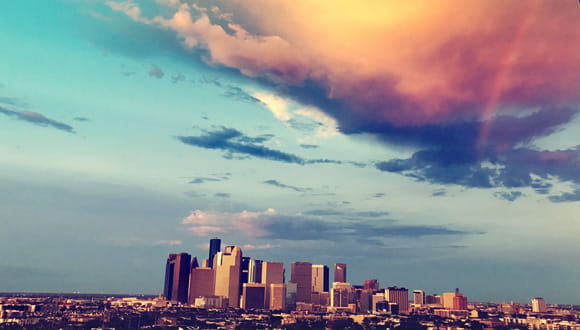What Happens When a Saharan Dust Cloud and COVID-19 Collide?
June 23, 2020 - Katie McCallumHoustonians are no strangers to Saharan dust — those enormous dust plumes that form over the Sahara Desert, travel over the Atlantic Ocean and linger over the city for a week or so.
These clouds of dust bring drier air, giving us a welcomed break from the Houston humidity, as well as vibrant sunsets that fill our Instagram and Facebook feeds.
While most of the dust floats high in the air above the city, some does fall toward the ground where it's easily inhaled.
"Once inhaled, this dust can irritate a person's airways and cause respiratory issues — especially if that person suffers from an underlying airway or bronchial disease, such as asthma or COPD," explains Dr. Tim Connolly, pulmonologist at Houston Methodist.
In reality, though, Dr. Connolly says that anyone can potentially feel the effects of a Saharan dust cloud as it hangs over the city for anywhere between one to two weeks.
Plus, this summer is different. As with most things these days, you may be wondering if the COVID-19 pandemic affects how you should prepare for a Saharan dust cloud, too.
"We're dealing with the new coronavirus, which itself can also lead to respiratory issues," Dr. Connolly says. "But the COVID-19 pandemic may potentially add some other interesting dynamics, both good and bad, to any Saharan dust clouds we may see this summer."
With a dust cloud on track to settle over Houston later this week, here are four ways the COVID-19 pandemic may impact how this Saharan dust cloud affects you, as well how you prepare for it.
Our air quality is better than usual right now
The COVID-19 pandemic has kept many of us in our homes more and in our cars less — and Houston's air quality has benefited significantly from it.
"Houston's air quality is typically pretty poor, and unfortunately, this regularly triggers a person's pre-existing breathing or airway issues," explains Dr. Connolly. "Adding a cloud of Saharan dust into the mix tends to make matters worse for these people."
But this summer's improved air quality might actually mean that the dust cloud may not be as problematic as usual.
People with underlying airway issues will still need to take extra precautions. To lessen the severity of symptoms you might experience, Dr. Connolly recommends:
- Frequently checking the air quality in your area
- Finding your rescue inhaler and make sure it's full and up-to-date
- Ensuring that other inhalers in your maintenance regimen are also ready for use
"By staying current on the air quality and making sure you have all the necessary supplies, you'll likely limit the risk of a serious exacerbation," says Dr. Connolly.
Your cloth face mask may protect you from the dust
The cloth face mask you wear to reduce the spread of COVID-19 may actually serve a dual purpose for the week or so that the Saharan dust cloud will hang over Houston.
"You should already be wearing a cloth face mask right now whenever away from home to limit the spread of COVID in our community. An added benefit of the mask is that it may actually also help reduce some of the effects that the dust cloud might have on your breathing when you're out of the house," Dr. Connolly says.
Just be sure that you're wearing, storing and washing your mask correctly.
The Saharan dust may mimic COVID-19 symptoms
Both COVID-19 and the Saharan dust cloud can cause overlapping respiratory symptoms, including:
- Dry cough
- Wheezing
- Shortness of breath
- Mild chest pain
This means that it will be important to know which symptoms distinguish a bronchial irritation from the dust cloud versus COVID-19.
"While both share some symptoms in common, an adverse reaction to the dust shouldn't cause fever, muscle aches, gastrointestinal issues or loss of smell," Dr. Connolly explains. "If you're experiencing any of these non-respiratory symptoms in addition to one of more of the respiratory symptoms above, call your doctor for guidance."
Many of us are outdoors more than usual
Whether you're just taking a walk to safely get out of your house or you've moved all of your workouts outside to avoid gyms and/or workout classes, many of us are outdoors way more than usual as a result of the COVID-19 pandemic.
"Exercising is great, as is being outdoors — both can benefit your mental and physical health," says Dr. Connolly. "However, the Saharan dust may be an irritant you weren't expecting, so you may want to go easy on the outdoor workouts for the next week or two."
Now, this doesn't mean that you need to lock your doors, pull down your blinds and sit on your couch for two weeks, but it does mean you may want to think twice before gardening in your backyard for two hours or going for a 10-mile run.
Instead, Dr. Connolly recommends moving your longer workouts indoors and shortening the length of any workouts you do outside.


